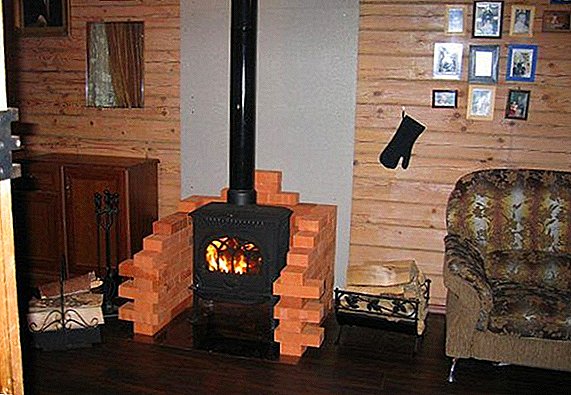 In the cold season, many living in private houses, on summer cottages or just in apartments, lack the heat, due to the fact that central heating can hardly be called effective, especially when there is frost outside the window. If you can put up with heating in multi-room skyscrapers, the private sector definitely needs its own heating system. And in this article we will talk about an economical and convenient variant of autonomous heating, which has become widespread among the northern peoples, which is called the stove. About its advantages and disadvantages, as well as the ways of creation and varieties will be discussed in this article. So, let's understand.
In the cold season, many living in private houses, on summer cottages or just in apartments, lack the heat, due to the fact that central heating can hardly be called effective, especially when there is frost outside the window. If you can put up with heating in multi-room skyscrapers, the private sector definitely needs its own heating system. And in this article we will talk about an economical and convenient variant of autonomous heating, which has become widespread among the northern peoples, which is called the stove. About its advantages and disadvantages, as well as the ways of creation and varieties will be discussed in this article. So, let's understand.
History of the stove
The basic version of the origin of the name is associated with the people who first used a similar furnace, that is, bourgeois. For the lower class, these devices were not available, but wealthy people could afford them. 
Starting from the 18th century, such furnaces massively flooded apartments and houses of all classes, as their design was improved and allowed to make fuel consumption more economical, which made it possible for even simple peasants to acquire this science and technology achievement.
Such devices gave two main advantages:
- heating, and in rooms of any size and purpose (residential buildings, household buildings, warehouses, garages, utility rooms, greenhouses, etc.);
- cooking, because the design allows you to warm up on the top panel food or tea.
It was possible to drown such heating mechanisms with anything: wood, coal, reed, sawdust, dry spruce fir trees and even straw. When centralized heating appeared in the 20th century, it seemed that the burzhuek age was over. 
But in the 60s, mass development of suburban and garage cooperatives began, where the stoves again found their application. Today, such mechanisms are used for heating utility rooms, greenhouses, country houses, warehouses, guards, private houses and many other premises.
Such undying popularity is justified by high heat emission, an order of magnitude superior to the most popular method of heating before the burzhuek, which was the fireplace.
For home improvement, you will be interested to learn how to make a warm floor with your own hands, how to install a sink in the countertop, how to properly rub the seams on the tile, how to make a wooden barrel, how to treat wood from rotting, how to make a coil for a watering hose, how to warm the basement foundations, how to sheathe the door, how to sheathe the walls with drywall.
What is a stove-stove
The stove-stove is usually a metal hollow body, under which is placed a tray for the ashes, resting on four legs and not in contact with the floor of the heated part.
A pipe is discharged from the body to the outside, along which smoke and carbon dioxide are emitted. The case is equipped with a screen, a convenient door with a handle, as well as some additional elements. Also, there are designs of a burzhuek with several sections, combustion chambers. 
Also, such furnaces are divided into several categories:
- oil (works on engine oil residues burning in one chamber, and oil vapors burn in the second chamber, thereby increasing heat transfer);
- gas;
- on diesel;
- on sawdust;
- pyrolysis;
- on coal;
- on the wood;
- on pressed briquettes;
- and other types, depending on the fuel used.
Did you know? Today, there are many options for stoves. They are trimmed with ceramics, veneered with marble, covered with elaborate embossing and stylized as fireplaces. But one of the most interesting options was a floating fire stove, which looks like a certain spaceship. Its body rests on a pipe that is attached to the ceiling, that is, the stove does not have a support on the floor. In this case, the pipe can be made of special glass with additional illumination, which will decorate the smoke going through the pipe, creating a truly fascinating spectacle.

The advantages and disadvantages of the stove
Among the advantages include:
- Low cost.
- Simplicity of design. With minimal skills to work with a welding machine, you can make a stove that will not be inferior in its characteristics to the factory.
- Versatility. Potbelly stoves work on almost any kind of fuel.
- Compactness. It will not occupy half of the room, like a Russian stove, even if you impose a brick on it. At the same time, despite the small size, the furnace retains all its functionality.
The disadvantages of such a stove include:
- Low efficiency (no more than 60%). For country houses with year-round living and increased requirements for heat transfer and hot water supply, it is required to consider a different heating option.
- Ineconomic. High fuel consumption occurs due to the simultaneous burning of all the wood in the furnace.
- A medium sized stove provides heat to only one room. If you connect it to a home heating system, you will have to significantly increase fuel consumption.

The principle of operation and scheme
The basic principle of the stove is in the process of pyrolysis, which is produced by the presence of two combustion chambers. In the first, located below, is the flue material, which can be any.
Further, through the system of special openings and passages, the resulting gases enter the upper chamber, where they (gases) ignite and also generate heat. The task of the stoker is only to correctly calculate the amount of fuel, because it directly affects the quality of the pyrolysis process.
For the arrangement of the dacha, it will be useful for you to learn how to make a decorative waterfall, garden swing, fountain, flower beds made of stones, rock arias, a dry stream, a summer shower, a sofa made of pallets with your own hands.
In addition, oxygen must be supplied in metered amounts of oxygen to the combustion chamber so that ignition occurs after mixing the gases. This is achieved due to the presence of a blower.
This technology will be effective if a balance is achieved between convection currents emanating from the combustion zone of the main fuel. There they should be slightly larger than the capacity of the flue pipe.  Simply put, there are two options that will be erroneous and which should be avoided:
Simply put, there are two options that will be erroneous and which should be avoided:
- Large firewood. With such an error, the volume of oxygen will be sufficient only to successfully maintain the processes of burning wood materials.
At the same time, there will not be enough air volume to burn the obtained gases during pyrolysis.
- Small tab. It all works the other way around. There will be too much air, which means that it will be distributed throughout the entire volume of the firebox, which is not completely filled. With such an error, the lion's share of air will evaporate, and the combustion of gases in the second chamber will be inefficient due to an excess of oxygen.
In both cases, the pyrolysis process will not be started, as an error is made.
Important! Only a well-defined rate of laying the fuel will allow you to start this process and get the highest heat transfer, which will rise to the level of 75%, despite the fact that conventional stoves and fireplaces do not give 30% of heat transfer.

The choice of heated space
In addition to the structural solution and auxiliary elements, as well as the expected fuel raw material, the final choice of the type and configuration of the stove is influenced by the room to be heated. About this later in our article.
Living quarters
In order to effectively heat a dwelling, you can use either a brick-made home-made stove or a cast-iron stove, bought in a specialty store. The main distinguishing feature between them is the time of melting.
If the cast-iron stove warms up quickly and will be so hot that it warms the air around it, then the brick oven will have to be melted for a rather long time (about 3-4 hours for full heating), after which it will give off heat from the heated wall during the day. 
Both are equally effective. The only thing worth paying attention to is ergonomics. For example cast iron potbelly stove will be much smaller and easier to operate, and modern metal heaters for houses are made with taste, design and interesting finish that will fit the stove into any interior.
But a massive brick oven will become a rather cumbersome accessory. In any case, the choice is yours.
Non-residential premises
For non-residential premises suitable stove made of any material. It can even be made independently, for example, using an old gas cylinder, a metal barrel or just a sheet of metal. 
Due to the presence of the necessary tools, a clear plan of action and a scheme for building a stove, you can quickly translate the goal into reality and provide your utility room with heat.
Such a potbelly stove will not differ in design refinement and external beauty, but it will be able to warm a small space around it.
Purchased wood stoves
The best of the stoves present on the modern market are the five aggregates described below.
- Furnace-stove "Ugolek-E10", domestic production, captivates its meager price that can close my eyes to a number of shortcomings. The price of such a device at $ 50 is available to everyone. True, the power of 5 kW and the absence of at least some design makes us look for more interesting options. But such a device is perfect for country houses, garages, guards and a number of outbuildings.
- Sergio Leoni ELIZABETH 164543 unequivocally wins the previous stove with its stunning appearance, compactness and high quality. Her ceramic facing will not leave anyone indifferent. The price for such a miracle of technology is also amazing - from $ 900 and above. But for large country houses, this option will be the best.
- Relatively inexpensive and stylish product is Germany. Thorma bergamo It combines high German quality, good design, acceptable power of 5 kW and a pleasant price. In this unit you will find everything you need, from adjustments to the hob. It is worth such a stove 550 dollars. For a country house or a small country house is the thing.
- Potbelly stove Bullerjan characterized by the fact that its design involves the use of not solid fuel, but gas. It is powerful, massive, simple and concise in work and in design, but is a real monster in the matter of heating. At a price of $ 350, such a machine will be able to give 18 kW of heat, which will allow to heat the huge rooms for any purpose.
- Another domestic oven Thermofor was the discovery of nano-engineering. It has undoubted advantages: small dimensions, high power of 13 kW, external beauty and stylish design. In a kind of rating, it ranks first in terms of price and quality. The price pleasantly surprises - 250 dollars. Such a device is suitable for country and country houses, warehouses, greenhouses and other large objects.




Potbelly stove with his own hands from the gas cylinder
In the previous sections, we talked about the fact that for non-residential premises you can make a stove-stove with your own hands. And now we will tell you how to do this with the help of an old gas cylinder, some tools and ingenuity.
It will also be useful for you to learn how to whiten the ceiling, how to make a snow shovel, how to install the air conditioner correctly, how to install a running water heater, how to install a switch and a socket, how to make plumbing from the well into the house, how to properly glue the wallpaper, how to warm the window on winter, how to remove the old paint from the walls.
Choosing the right cylinder
It is best to use an old gas cylinder (of course, there should not be gas in it). In order to prevent the explosion of gas residues, they must be vented, leaving the cylinder open for a while.
Inspect such a cylinder for rust or mechanical damage, as they are undesirable when assembling the stove. According to capacity, choose a cylinder of 33 or 50 liters for heating large rooms, such as a garage, and for more compact ones, you can use a 10-liter bottle.
Gas stove from the gas balloon do it yourself: video
Preparation of the necessary tool
For work you will need:
- Bulgarian;
- hammer;
- chisel or chisel;
- drill;
- welding machine.
The main stages of manufacturing
So, when all the necessary tools are prepared, and the balloon has been completely vented from possible gas residues, you can proceed to the assembly of the stove with your own hands.
Step 1. Using the grinder, file the cap that covers the valve. The valve itself can be twisted. After the notch on the cap, lightly tap it around with the pointed part of the hammer. Next, arm yourself with a chisel or chisel and detach the cap from the cylinder. Do the same with a metal lining under the cap. 
Step 2. Now you can cut off the valve itself, again with the help of the grinder. Without finishing the cut, take the hammer and knock down the valve. Now there is a hole in the balloon that you need to fill the balloon with water, which you have to do next. 
Important! Water is necessary in order to produce a sawing cylinder, as the upper part will have to be removed. In order to properly fill the cylinder with water, it is necessary to provide an outlet for air, otherwise the container will simply not be filled. To do this, use a thin hose, which should fit loosely on the hole, and low water pressure.
Step 3. When the cylinder is filled with water, it should be tilted to the side, after having previously plugged the hole with a gag (a simple wooden one, extruded from a branch). The cylinder itself during sawing must always roll back and forth, gradually turning and continuing sawing evenly throughout its diameter. At the end of your cover completely separated from the walls. 
Step 4. In the lid itself, it is necessary to make another round hole of small diameter for the gate valve (to block or open the exit to the smoke). The lid will continue to serve as a door on which the curtains need to be welded, as well as a round exit for the gate valve. In the hollow metal circle of such an outlet, it will be necessary to make two holes at the same level, and then thread an axis into them with a handle at one end and a spring at the other for a slide gate valve. On the axis itself, a round valve should be welded to the diameter of the cut hole in the cylinder cap.
Step 5. The walls of the balloon themselves must be further strengthened near the resulting cut. To do this, on both sides it is necessary to ring the cut with metal plates that are welded to the main wall from the outside and from the inside. Asbestos cord should be laid between these plates. Fasteners for the handle can be welded to the metal plates, and a handle with a locking mechanism, respectively, can be welded to the lid itself. 
Step 6. In the body of the cylinder need to make holes for the grate. To do this, drill first with a triple drill, then use a six. It is necessary to make 4-5 rows of holes in each direction from the central seam on the walls of the cylinder, and one should not go beyond the middle of the length of the container. 
Did you know? In order to better drill holes on an uneven, round surface, you should initially go to the right places with a hammer and a thick nail or cone-shaped chisel.
Step 7. It is also necessary to weld four legs to the cylinder itself, and in addition, a special rectangular container at the bottom of the structure, into which you insert a box with a handle for collecting and conveniently removing the ashes. Such capacity is necessarily assembled from metal and mounted on top of the grate openings. 
Step 8. At the bottom of the cylinder a hole is drilled under the chimney pipe. Before installing the pipe itself, a special metal partition with a depth of two-thirds of the diameter must be welded inside the cylinder, which will prevent the weathering of the heat. 
Step 9. Inside the container, where the door with a blower, you need to attach a vertical visor with a length of 10-12 centimeters, which will delay the smoke when you open the stove. This is an element of added convenience, so that the smoke does not go into your eyes when you open the door. 
Step 10. Install the pipe of the required length and weld the seam.
Congratulations, your new stove is ready for testing and further operation. As an additional decor, it can be painted in any color, but only heat resistant paints should be used.
Security measures in the manufacture and use of the stove-stove
During the whole process of assembling the stove at home, it is imperative to adhere to the safety rules:
- wear gloves to protect your hands while working with the welding machine;
- wear a protective mask on the eyes and face when working with the welding machine;
- Be extremely careful and attentive when performing drilling work.

Also important is the observance of safety rules during the use of the stove in business, namely:
- Для разжигания дров нельзя применять легковоспламеняющиеся жидкости, например, бензин или ацетон. Такое действие может стать причиной сильного взрыва.
- Нельзя открывать заслонку поддувала целиком на продолжительное время. The heat can seriously bend the walls and burn the chimney.
- The use of wood or coal as a primary fuel material is undesirable. Too high temperature of burning of these substrates can literally melt the body of the stove.
- Furniture, carpeting, flammable textiles and all interior elements, including a container of fuel, should be kept at least 1 meter away from the stove.
- Always keep the fuel door closed.
- It is forbidden to continue operational activities in case of detection of blockage in the stovepipe chimney.
- It is impossible to leave a functioning stove-stove for a long time without supervision, as this may cause a fire.

If you follow the rules for operating a heating unit, especially one created by yourself, as well as precautions and safety measures described here, such a stove can serve you for a long time and effectively, and it will not bring any force majeure or undesirable consequences for you or your home.
Today in the world created many ways to heat residential and non-residential premises. One of the most popular and widely used methods is just the stove, which you can now collect with your own hands.
It is important to be guided by step-by-step instructions and not to neglect the prescribed safety rules, so that the whole creative process, so to speak, gives you only pleasure, and the end result has pleased and warmed for many years.












